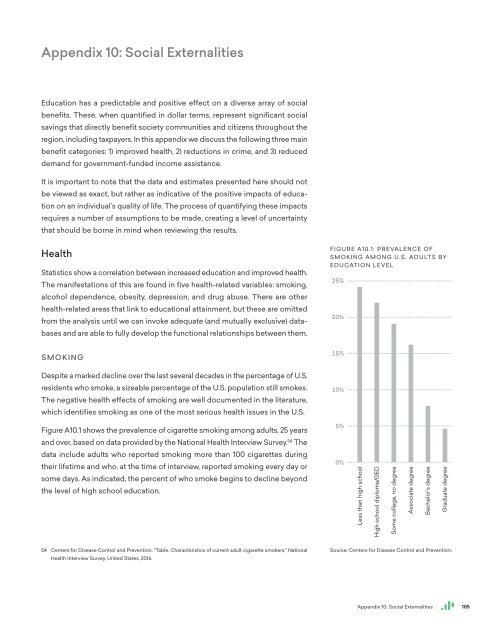The Economic Value of WTAMU Main Report
This report assesses the impact of West Texas A&M University (WTAMU) on the regional economy and the benefits generated by the university for students, taxpayers, and society. The results of this study show that WTAMU creates a positive net impact on the regional economy and generates a positive return on investment for students, taxpayers, and society.
This report assesses the impact of West Texas A&M University (WTAMU) on the regional economy and the benefits generated by the university for students, taxpayers, and society. The results of this study show that WTAMU creates a positive net impact on the regional economy and generates a positive return on investment for students, taxpayers, and society.
Create successful ePaper yourself
Turn your PDF publications into a flip-book with our unique Google optimized e-Paper software.
Appendix 10: Social Externalities<br />
Education has a predictable and positive effect on a diverse array <strong>of</strong> social<br />
benefits. <strong>The</strong>se, when quantified in dollar terms, represent significant social<br />
savings that directly benefit society communities and citizens throughout the<br />
region, including taxpayers. In this appendix we discuss the following three main<br />
benefit categories: 1) improved health, 2) reductions in crime, and 3) reduced<br />
demand for government-funded income assistance.<br />
It is important to note that the data and estimates presented here should not<br />
be viewed as exact, but rather as indicative <strong>of</strong> the positive impacts <strong>of</strong> education<br />
on an individual’s quality <strong>of</strong> life. <strong>The</strong> process <strong>of</strong> quantifying these impacts<br />
requires a number <strong>of</strong> assumptions to be made, creating a level <strong>of</strong> uncertainty<br />
that should be borne in mind when reviewing the results.<br />
Health<br />
Statistics show a correlation between increased education and improved health.<br />
<strong>The</strong> manifestations <strong>of</strong> this are found in five health-related variables: smoking,<br />
alcohol dependence, obesity, depression, and drug abuse. <strong>The</strong>re are other<br />
health-related areas that link to educational attainment, but these are omitted<br />
from the analysis until we can invoke adequate (and mutually exclusive) databases<br />
and are able to fully develop the functional relationships between them.<br />
SMOKING<br />
Despite a marked decline over the last several decades in the percentage <strong>of</strong> U.S.<br />
residents who smoke, a sizeable percentage <strong>of</strong> the U.S. population still smokes.<br />
<strong>The</strong> negative health effects <strong>of</strong> smoking are well documented in the literature,<br />
which identifies smoking as one <strong>of</strong> the most serious health issues in the U.S.<br />
Figure A10.1 shows the prevalence <strong>of</strong> cigarette smoking among adults, 25 years<br />
and over, based on data provided by the National Health Interview Survey. 54 <strong>The</strong><br />
data include adults who reported smoking more than 100 cigarettes during<br />
their lifetime and who, at the time <strong>of</strong> interview, reported smoking every day or<br />
some days. As indicated, the percent <strong>of</strong> who smoke begins to decline beyond<br />
the level <strong>of</strong> high school education.<br />
FIGURE A10.1: PREVALENCE OF<br />
SMOKING AMONG U.S. ADULTS BY<br />
EDUCATION LEVEL<br />
25%<br />
100+91+79+67+32+19<br />
20%<br />
15%<br />
10%<br />
5%<br />
0%<br />
Less than high school<br />
High school diploma/GED<br />
Some college, no degree<br />
Associate degree<br />
Bachelor’s degree<br />
Graduate degree<br />
54 Centers for Disease Control and Prevention. “Table. Characteristics <strong>of</strong> current adult cigarette smokers,” National<br />
Health Interview Survey, United States, 2016.<br />
Source: Centers for Disease Control and Prevention.<br />
Appendix 10: Social Externalities<br />
105





